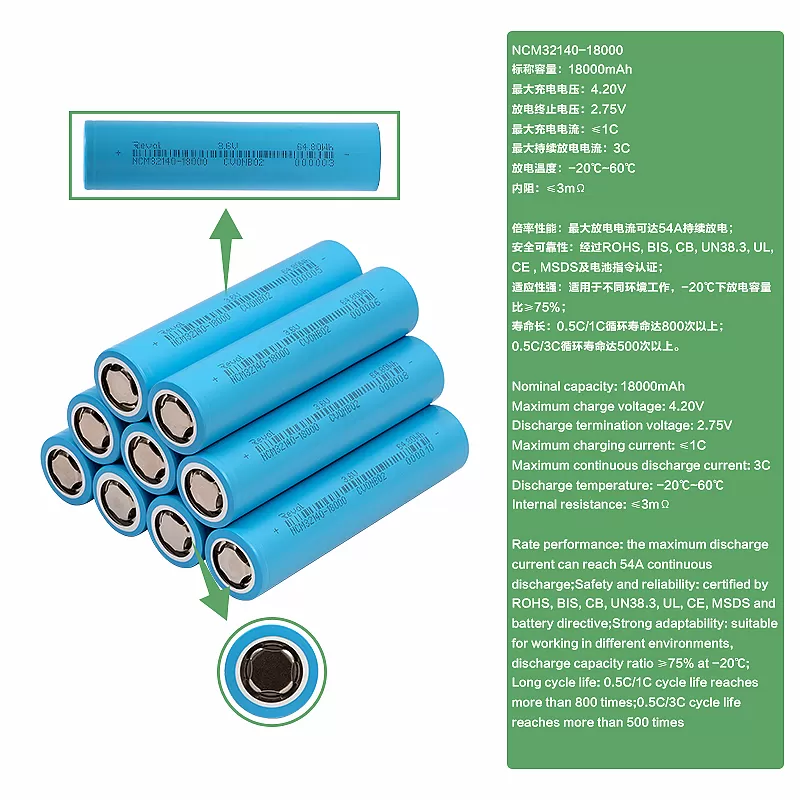32140 Lithium-ion vs 32140 Sodium-ion Battery Cells: A Comparison Guide
As the global demand for efficient and sustainable energy storage solutions grows, the debate between 32140 lithium-ion and 32140 sodium-ion battery cells has intensified. Both cell types are gaining attention in applications ranging from electric vehicles (EVs) to grid storage. This article provides a comprehensive comparison of these two battery technologies, focusing on their specifications, advantages, disadvantages, and current market relevance.
? What Are 32140 Battery Cells?
The 32140 battery cell format refers to cylindrical cells measuring approximately 32 mm in diameter and 140 mm in length. This size is commonly used in applications requiring high energy density and robust performance, such as electric vehicles, energy storage systems, and industrial equipment.
⚡ Energy Density and Performance
Energy Density: Approximately 172 Wh/kg.
Cycle Life: Over 3,500 cycles at 80% depth of discharge.
Operating Temperature Range: -10°C to 60°C.
Advantages: High energy density, long cycle life, and established technology.
32140 Sodium-ion (Na-ion):
Energy Density: Typically between 100–150 Wh/kg.
Cycle Life: Ranges from 2,000 to 5,000 cycles, depending on the specific chemistry.
Operating Temperature Range: Effective performance up to 60°C.
Advantages: Improved thermal stability and safety, especially in extreme temperatures.
While Li-ion cells offer higher energy density, Na-ion cells are closing the gap with advancements in materials science, making them increasingly competitive for certain applications.
? Cost and Material Availability
Lithium-ion:
Relies on scarce and geographically concentrated materials like lithium and cobalt.
Subject to price volatility due to supply chain constraints.
Sodium-ion:
Utilizes abundant and widely available materials, leading to potentially lower production costs.
Offers a more sustainable and environmentally friendly alternative.
The abundance of sodium makes Na-ion batteries a cost-effective option, particularly for large-scale energy storage solutions.
? Safety and Thermal Stability
Lithium-ion:
Higher risk of thermal runaway and fire hazards if damaged or improperly managed.
Requires complex battery management systems to ensure safety.
Sodium-ion:
Enhanced safety profile with lower risk of overheating and combustion.
Better performance in high-temperature environments, reducing the need for extensive cooling systems.
Na-ion batteries' superior thermal stability makes them particularly suitable for applications in harsh or variable climates.
? Environmental Impact and Sustainability
Lithium-ion:
Mining and processing of lithium and cobalt have significant environmental footprints.
Recycling processes are complex and not yet widely implemented.
Sodium-ion:
Production involves more environmentally benign materials.
Easier to recycle and dispose of, contributing to a more sustainable lifecycle.
The environmental advantages of Na-ion batteries align with global efforts to develop greener energy storage technologies.
? Applications and Market Trends
Lithium-ion:
Dominates the EV market due to its high energy density and mature technology.
Widely used in consumer electronics and portable devices.
Sodium-ion:
Emerging as a viable option for grid storage, backup power systems, and applications where safety and cost are paramount.
Gaining traction in regions with limited access to lithium resources.
Companies like CATL are investing in Na-ion technology, indicating a growing interest and potential for wider adoption in the near future.
✅ Pros and Cons Summary
| Feature | 32140 Lithium-ion | 32140 Sodium-ion |
|---|---|---|
| Energy Density | Higher (~172 Wh/kg) | Moderate (100–150 Wh/kg) |
| Cycle Life | Long (>3,500 cycles) | Moderate to Long (2,000–5,000 cycles) |
| Cost | Higher due to material scarcity | Lower due to abundant materials |
| Safety | Requires complex management systems | Inherently safer with better thermal stability |
| Environmental Impact | Higher due to mining and processing | Lower with more sustainable materials |
| Market Maturity | Established and widely adopted | Emerging with growing interest |
? Conclusion: Which Is Better for Your Needs?
The choice between 32140 lithium-ion and sodium-ion battery cells depends on specific application requirements:
Choose Lithium-ion if you need:
High energy density for space-constrained applications.
Proven performance and established supply chains.
Choose Sodium-ion if you prioritize:
Cost-effectiveness and material sustainability.
Enhanced safety and thermal stability.
Applications in stationary energy storage or regions with limited lithium availability.
As technology advances, sodium-ion batteries are expected to play a more significant role in the energy storage landscape, offering a complementary alternative to lithium-ion solutions.




